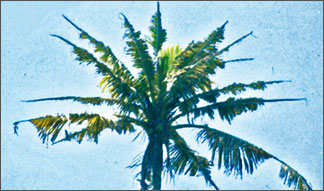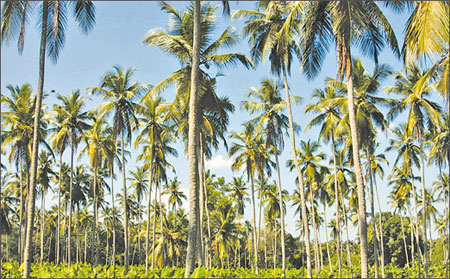|
400,000 ‘sick’ coconut trees uprooted:
Crop diversification to offset blight-hit plantations
By L.S Ananda WEDAARACHCHI

“Blight - hit” coconut palm |

Better managed coconut land |
|

Plantation Minister Mahinda Samarasinghe
|
A crop diversification scheme and a compensation program to ensure
economic losses will be implemented against in respect of the blight-hit
coconut palms in Galle, Matara and Hambantota districts.
Coconut Research Institute (CRI), Director General Dr. (Ms.)
Chitrangani Jayasekera said that short-term crops such as vegetables,
fruits, pulses, cinnamon and whenever possible even rubber and tea could
also be planted in the affected coconut lands.
The current coconut blight is similar to that of the dreadful AIDS.
No medicine has yet been found for AIDS - as well as “Weligama Wilt”
which is very much similar to “Kerala Wilt” in India. “Kerala Wilt” was
discovered in Kerala, a century ago and later it spread to Karnataka and
now spreading to the other regions of India. A series of studies and
research have been undertaken in India and a special research centre,
“Kaungulum Centre” was also set up for this purpose.
After “Weligama Wilt” was discovered in September 2007, the CRI
engaged in a series of studies and research to find an effective way of
treating the blight. Local scientists were sent to the Kaungulum
Research Station, India and a workshop funded by FAO was also held in
Negombo last year. In March, 2008, the authorities declared the
“Weligama Wilt” a dangerous vector. Transportation of coconut seedlings,
raw coconut leaves, nuts with husk has prohibited as a preventive
measure. Weligama Plant Nursery was also closed down. Such precautions
resulted in checking the spread of the blight to other parts of the
island especially the Coconut Triangle of the country, Dr. Jayasekera
said.
Coconut Cultivation Authority (CCA) Director Montague Sarachchandra
said that a special team has been assigned to visit the coconut lands to
identify and report the blight hit coconut trees on a directive by
Plantation Minister Mahinda Samarasinghe. This assignment has to be
completed within two weeks, commencing June 10. It has been estimated
that around 400,000 trees affected, have to be destroyed with as early
as possible and cultivate alternative short-term crops in those lands,
he said.
He said that the blight cannot be treated to restore the trees. Once
the disease erupts, it would spread to others, he said.
He said that the CCA has launched a number of programs during the
past years to expand the coconut cultivation in Sri Lanka.
It was extended to new areas such as the Northern Province and the
Moneragala district.
Coconut saplings were issued free along with a fertiliser subsidy in
the scheme to replace the old coconut trees, he said.
“Kapruka”, a low interest loan upto Rs. 2.5 million for coconut lands
of over five acres were also introduced by the CCA as an incentive to
replace their old plantations with the new, he said.
A spokesman for the marketing Division of the Coconut Development
Authority (CDA) said the uprooting of 400,000 blight hit coconut trees
would certainly have its impact on the market.
The contribution to the overall production from the affected areas is
less than 3 percent.
We are not self-sufficient in coconut or its by-products.
Palm oil is imported since coconut oil production is not sufficient
to cater to the local demand. The total acreage of coconut cultivation
in the island is about 965,000 acres, he said.
He said that the average produce in most of the small scale coconut
lands is poor.
It is less than 2,800 nuts per acre when compared 7,500 in better
managed coconut lands.
Most of the smallholders do not maintain their lands properly which
results in poor harvests, he said.
The coconut industry has a history of 150 years.
There was a discernible improvement of the industry since 2000
foreign earnings improved.
During last year there was a drop in foreign exchange mainly due to
the poor harvest.
Although the local demand is for more than 3,500 million, the
production amounts to less than 2,900 million, he said.
It is important to look after the coconut cultivations carefully and
maintain them properly applying fertilizer in time.
People should go for better varieties such as “Tall and Tall” which
takes eight years for the harvest, he said. |

